#Kemeticism
Text
Casual ways to connect with your deities
-Pray to them or just just talk with them and tell them about your day
-Light a candle and say your thanks
-Offer your meal/snack to them or bake/cook with them or for them
-Watch a movie in their honor
-Offer your morning drink to them or make a cup for them
-Assign them a plant and take care of it as a devotion to them
-Listen to music that reminds you of them
-Say good morning/good night
-Thank them for the things you see that you consider beautiful

#paganism#pagan#polytheism#hellenic polytheism#hellenic pagan#hellenic paganism#hellenism#kemetic#kemeticism#heathenry#heathenism#norse paganism#deity devotion#deities#deity#deity work
4K notes
·
View notes
Text
Low Energy Devotional Activities and Ways to Connect with the Gods
Let's be honest, religion and consistent practice can be HARD, especially when you're chronically ill, disabled, mentally ill or neurodivergent. This is a list of lower energy practices you can do to connect with your Gods when you're having a rough day.
Pray. You don't have to say the prayer. You don't have to do the full cleansing and offering. Just think about the prayer. It could be as simple as "'Deity Name', thank you. I'm thinking of you and appreciate you."
Dedicate any self care you do to the Gods. You've got to take meds? awesome. it's now a devotional activity.
If you can, light a tea light candle. You can think about who you're dedicating it to as you're lighting it.
Tell them about your day. Have a simple conversation with them (again, this can be in your head if needed).
Offer some water! Water is a great offering if you don’t have the energy to cook, collect or buy something.
Incense is also a great offering because you can light it then forget about it and your house won’t burn down (if you follow regular safety measures).
Resting. Your deities want you to be okay. Dedicating your rest to your deities is especially great if you feel guilty for allowing yourself time to heal.
Turn on a video of someone reading mythos!
Put on a deity playlist. There are plenty of pre-made ones on Spotify.
Veil or bind your hair! Whenever I’m low energy I’ll throw my hair in a ponytail and bind it that way. It doesn’t have to be extravagant.
Make a Pinterest board for them!
Post on a digital altar! There are plenty of discord servers that have digital altars and temples. You could also make a devotional Tumblr blog.
Change your phone lock/home screen to something that reminds you of your Deity.
I hope this is helpful to anyone who needs it! Take care of yourself first and foremost. If you don't think you can manage something on this list then thats perfectly fine too! you're not a bad person for not being able to do something spiritual or religious. Ultimately, these things are not a necessity. Don't stress :)
#witchblr#witchcraft#pagan witch#paganism#hellenic polytheism#witch#witches#baby witch#beginner witch#hellenic pagan#pagan#paganblr#hellenic paganism#disabled witch#spoonie witch#chronically ill witch#neurodivergent witch#neurodivergent witchcraft#spiritual#kemeticism#kemetic#norse paganism#heathenry#heathen#norse pagan witch#norse polytheism#T's original witchy posts
3K notes
·
View notes
Text
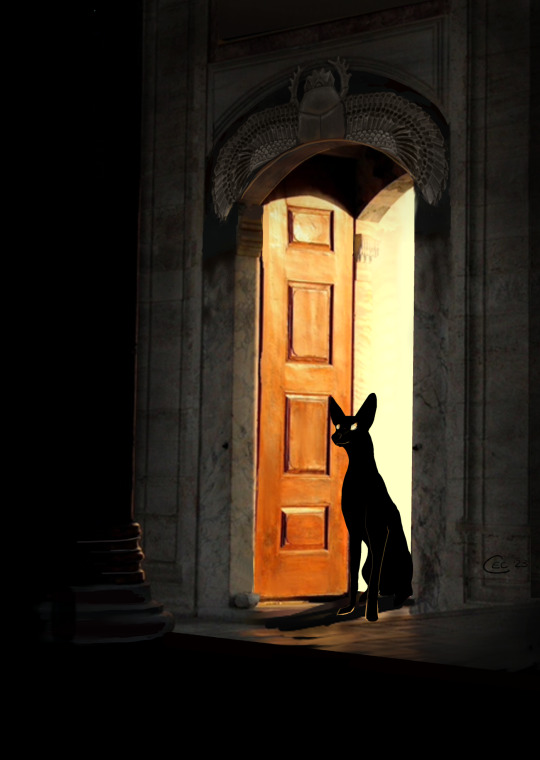
A guide will be waiting for you.
#art#artists on tumblr#anubis#tw: scopophobia#kemetic#kemeticism#dog#ancient egyptian mythology#mythology#egyptian mythology
3K notes
·
View notes
Text
“You worship so many deities how do you keep up with them all?”
Yes, that is kind of the point of polytheism.
Polytheistic worship includes a massive web of Gods who are all connected in some way or another, their domains overlapping as they work together.
You are just one person so you only have so much time and energy, of course you would worship one Deity who is linked heavily to your journey more than others.
You dont have to be every Deity’s devotee, just like you dont have to be everyones best friend. Sometimes you worship for a specific time, purpose or to bond with a loved one who worships that Deity.
Like I said in my previous post, the Gods will not get angry or clingy if you dont pay attention to them, they existed and have been worshipped way before you were born and way after you are dead.
If you devote yourself to a deity, dont be afraid to acknowledge their family, in fact they will encourage it.
1K notes
·
View notes
Text
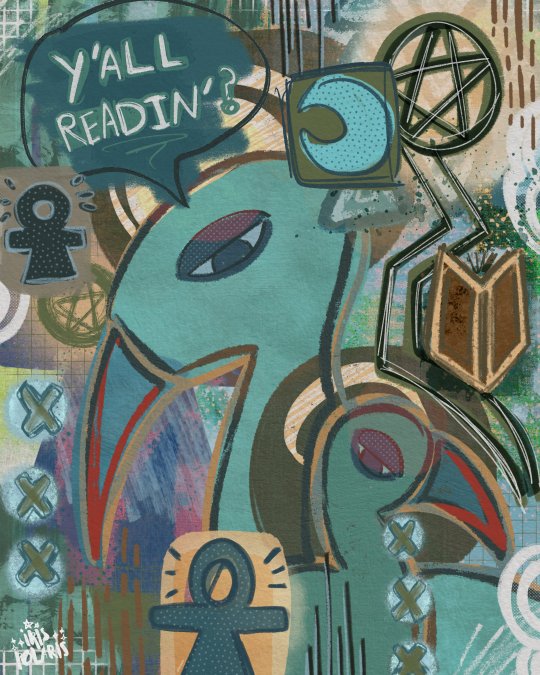
thoth knows the answer (digital, 2024)
[prints]
#digital art#naive art#primitivism#original art#weird art#kemetic paganism#kemeticism#kemetic#thoth#egyptian god#egyptian gods#egyptian mythology#mythology#myth#ibis#myths#reading#books#books and reading
466 notes
·
View notes
Text

Maat, the personification of the order behind the universe, the way things should be. The Kemetic path turns us always back to Maat.
#Maat#Kemet#Kemetic#Kemeticism#Egypt#egyptology#Egyptian#ancient Egypt#ancient Egyptian#egyptian gods
545 notes
·
View notes
Text
the cure for loneliness is sitting in a peaceful spot, lighting a little candle and inviting a deity you love to join you
#immediate happiness and comfort or your money back#the little flame is your friend too#domesticated fire 🥺#pagan witch#hellenic pagan#hellenic polytheism#polytheism#deity work#witchcraft#kemeticism#norse heathenry#deity devotion#paganism
658 notes
·
View notes
Text
lovely polytheists, what epithet of your God(s) are you closest with ? 🎭
#both very curious and looking for inspiration 👀#helpol#hellenic polytheism#norse paganism#kemeticism#egyptian paganism#heathenry#paganism#theoi#epithets
241 notes
·
View notes
Text
your faith and path are completely valid no matter the amount of time that passed since you chose to pursue them. you don't need 14+ years of research and knowledge to consider yourself pagan.
you do not need to have had “pagan signs” since you were a kid to become pagan; you do not need to have always known paganism's existence in modern times to call yourself pagan; you do not need to look for things you did in your childhood to “justify” your path.
you can be pagan even if you spent the past years without thinking about paganism, even if your religious (or non-religious) background was so different than what you believe in now.
if you feel at home and comfortable with this path, you are pagan — no matter if you discovered it a week ago or more than four years ago.
i see you and i support you; your beliefs are valid and they cannot be taken away from you by someone else.
#✉️ @ paganism#pagan#paganblr#paganism#pagan witch#kemetic paganism#norse paganism#pagan tips#hellenic pagan#norse pagan#kemeticism#kemetic#helpol#hellenismos#hellenic polytheism#norse pantheon#pantheon
317 notes
·
View notes
Text
The Ultimate Deity Journal Guide
Similar to my grimoire guide, this is a guide on deity journals.
What Is A Deity Journal?
A deity journal is a journal dedicated to a deity. It’s filled with information, offerings, devotional pieces, etc. If you like journaling or can’t give other physical offerings (like food, libations, etc.), it’s one of the best offerings out there.
What Do I Use For It?
Usually deity journals are physical journals and notebooks. Binders and folders work as well. I have seen deity journals online, using things like Notion or Google Docs. Those are a little harder to format, but are great if you don’t have a notebook or aren’t a fan of physical journals.
So, What Do I Put In It?
Devotional Artwork
Devotional Playlists
Pressed/Dried Flowers or Herbs
Prayers
Devotional Poems or Stories
Myths
Recipes
Stickers
Experiences or Dreams
Photos
The Basics (Name, Epithets, Domains, Family, Associations, Holidays, Symbols, Sacred Days, Sacred Animals, Etc.)
Spells/Rituals That You Want To Or Have Done With Them
Offerings And Devotional Act Ideas
Journal Prompts
Magazine/Book Cutouts
Hymns
Shopping List (Things You Want To Buy For Them)
Fabric Scraps
Letters To Them
Divination Readings With Them
Coins Or Other Currencies
How You Celebrate (Or Plan To) Holidays Or Sacred Days With Them
UPGs
Altar Plans (Drawings Or Descriptions Of Altar Ideas)
Incense, Herb, And Oil Blends
Drops Of Wax, Wine, Etc.
Seed Packets
Blessings
Charms
Charm/Spell Bags
Travel Plans (Places You Want To Go For Your Deity)
Maps That Remind You of Them
Sigils Dedicates To Them
Superstitions Related To Them
Research On Their Birth Place
Devotional Jewelry Charging Station
Affirmations Dedicated/Influenced By Them
Small Sticks Or Branches
Book Annotations
Divination Techniques Related To Them
Relationship Goals (Better Communication, More Signs, Etc.)
Their Associated Rune/Tarot Card/Etc.
Teas And Tea Blends
Folklore/Mythology Entities Related To Them
Vision Board
Goals
Diary Entries And Rants
Taglocks
Paper/Straw/Etc. Dolls
Doodles
References/Further Reading
#deities#witchcraft#baby witch#beginner witch#witch#witchy#witchblr#helpol#hellenism#norse paganism#celtic paganism#slavic paganism#kemetism#kemeticism#Kemetic#hellenic#hellenic witch#deity#deity work#deity worship#worship#devotional act#offering#devotional journal#witches#witchery#devotion#deity devotion
745 notes
·
View notes
Photo
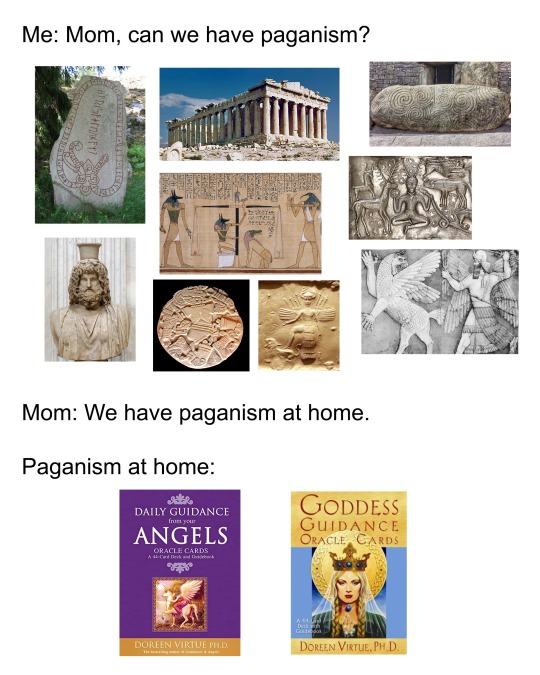
#pagan memes#paganism#neopaganism#memes#hellenic paganism#hellenic polytheism#helpol#norse paganism#asatru#egyptian paganism#kemeticism#mesopotamian mythology#sumerian#celtic paganism#doreen virtue
747 notes
·
View notes
Text









Dua Bast! Dua Bastet!

#dua bast#dua bastet#bast#bastet#kemetic#kemetism#kemeticism#kemetic witch#kemetic paganism#moodboard#deity#deity work#deityboard#witchywitchesshit#witchblr#witches on tumblr#witches of tumblr#witch#witchy#witches#witchcraft#pagan#paganism#pagan witch#coolstuffsnow#netjeru
308 notes
·
View notes
Note
. . .Osiris
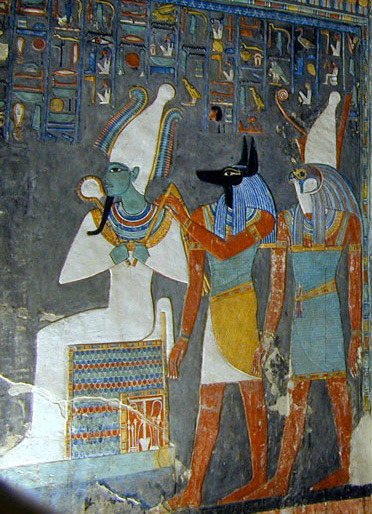
Osiris (Great and Beautiful is He) is the God of the Underworld; its King and Pharaoh ruling over the Duat. He is pictured here on the far left, His skin green and His body in mummiform. This is commonly how He is depicted; as a green-skinned, mummified man.
Son of Nut, the Sky Goddess, and Geb, the Earth God, Osiris was the first King of Egypt in accordance with Kemetic mythology, although there are stories that recount Geb, His father, being King before Him. There are a great deal of myths and stories that surround and involve Osiris, and I suppose it is important to at least skim over them before discussing hard facts about Him, as it gives some reference as to who He is and what the culture surrounding Him is like.
Osiris Myth
After the world was created, the Demiurge (who changes according to myth, and can be Neith, Ra, Amun, Ptah, or others) produces children; in the most popular form of this creation story, it is usually Ra who births the first Gods. They are Shu and Tefnut, Air and Moisture. Shu and Tefnut then form a union and birth two children of Their own: Nut and Geb, Sky and Earth. Nut and Geb were very much in love and refused to separate from each other, which, of course, caused a problem, because if the sky and the earth are eternally in contact, there is no space for anything to live and walk upon the earth. Ra made it so Nut and Geb were forever separated, by having Shu, air, stand atop Geb and hold Nut up as the sky. But Nut was already pregnant. When Ra discovered this, He was enraged, and forbade Nut from ever giving birth on any day of the year.
Nut cried to Djehuty (Thoth), and Thoth devised a plan. He went to Khonsu, God of the Moon, and set up a gamble, saying that every round of the game Senet Khonsu lost, He would have to give Nut some of His moonlight. Khonsu ended up losing so many times that Nut had enough moonlight for five days––five days that weren't in the calendar. This allowed Her to give birth on those five days, and on each day She had a different child; Ausir (Osiris), Wr-Heru (Horus the Elder), Sutekh (Set, Seth), Auset (Isis), and Nebet-Het (Nephthys). Nut and Geb were still forever separated by atmosphere (Shu), but the five Gods were birthed, and Osiris, as the eldest son, became King of the Living World.
As a side note, all Gods do have ancient Egyptian names which are different from Their Greek and now modern names. For convenience's sake, and to avoid confusion, I will use the names They are most known by; Their Greek/modern names. And as another side note, there are a lot of variations on this story. I will be piecing together a lot of different ideas but I will be leaving some things out for the sake of cohesion.
When Osiris came to Egypt, He found the people there to be chaotic and lawless. As King, He instituted laws and spread ma'at, which is truth, justice, harmony, and order. Egypt flourished under His rule and the people were incredibly happy, as all were equal, and with the fertility of the God-King, the crops were always bountiful and food was plenty. He brought not only law and prosperity, but also the right way to worship, and the teachings of agriculture.
Set, God of chaos, confusion, the desert, and of foreigners, and the youngest brother of the Ennead, grew to be quite jealous of His older brother. There are many variations and the most popular variation of this story comes from the end of the New Kingdom (1550-1070 BC), where Set fashions a fabulous coffin in the perfect measurements of Osiris, throws a party, and tells the party-goers that whomever the coffin fits may have the coffin as a gift. When Osiris fits perfectly, Set quickly shuts and bolts the coffin and throws it in the Nile (this version of the myth gives an origin to the idea that people who drowned in the Nile were holy). His coffin drifts downstream and into the Mediterranean, where it washes ashore in Phoenicia, in Byblos. The coffin wedges itself into a growing tamarisk tree, a tree which envelops the coffin. Eventually the tree is cut down and used as a pillar in the palace in Byblos.
Isis, Osiris' wife and sister, searched far and wide for Her husband, and did eventually find Herself in Byblos. The story is quite long and complicated, but in the end She convinced the King to give Her the pillar, and when she returned to Egypt, She hid Osiris in a swampy area of the Nile delta, and bade Her sister, Nephthys, to watch over Him while She went in search of healing herbs. But Seth heard that Osiris was back, and so after interrogating His sister-wife, Nephthys, He found Osiris, cut His body into pieces, and threw them into the Nile.
Isis was horrified at what transpired in Her absence, but She immediately set to work on finding the many pieces of Her husband with the help of Her sister, Nephthys. They managed to find every piece of His body except His phallus, which had been eaten by an oxyrhyncus fish, a fish that was thus forbidden to eat.
With the pieces of Osiris reassembled, and the healing powers of Isis in full power, Osiris was brought back to life, but incomplete. Isis assumed the form of a kite, and from above drew out the seed of Osiris, impregnating Herself with Their child: Horus the Younger. But Osiris, still incomplete, could not properly rule over the land of the living any longer.
This is why He is the ruler of the dead––He was once the king of the living, was killed, and was resurrected, and this is what every ancient Egyptian expected and hoped would happen to them: that they would die and be resurrected. In tombs and mortuary temples you will always see Pharaohs associating themselves with Osiris.
But this long myth I have just told you is not the only version of the story, and in my opinion, it is definitely the longest version of the story. Back in the Old Kingdom and Middle Kingdom there were several different versions; for example, Set's motive is different, ranging from revenge for Osiris kicking him, to revenge for Nephthys (Seth's sister-wife) sleeping with Osiris (which eventually births Anubis). Some texts claim that Seth took on the form of a wild animal, such as a crocodile or a hippopotamus, and killed Osiris that way. In others, Osiris is drowned. In some, the steps surrounding the coffin are skipped, and Osiris is simply cut up, and His pieces scattered around Egypt; a version which explains the many cult centers of Osiris claiming to be a place where Osiris is buried. Osiris' resurrection is also often helped along by other Gods such as Thoth (God of wisdom) and Anubis (God of embalming). In some versions, Set is killed for His actions. In most He is simply defeated and driven from the land, as chaos is necessary for balance and harmony, and thus cannot be killed. And the story that I have told is from the Late Period, recorded by Plutarch, and does not really go along with many Egyptian accounts, which often find Osiris' penis intact.
So that is the Osiris myth with all of its' intricacies and changing rhythms over the course of 4,000 years of Egyptian history. It embodies a huge amount of cultural practices and religious ideas within ancient Egypt, including the idea of truth, harmony, and justice, as well as resurrection, the afterlife, healing, and the workings of the cosmos. I've decided to leave out the later parts involving Osiris' son, Horus, and His fight with Set, for now because this does not directly involve Osiris, and that is our topic for this post.
Tradition, History, and Culture
Worship of Osiris dates back to the Old Kingdom, but the idea of Osiris is likely older than this. Before Osiris was actually Khentiamenti, an agricultural God centered in Abydos, a city which would later become the cult center of Osiris. Khentiamenti means 'Foremost of the Westerners', a title for the ruler of the dead, as the dead resided in the west, where the sun set each day. But Osiris Himself is not found mentioned in any texts or carvings until the 5th Dynasty, where He is depicted as a man wearing a divine wig. Later on He would take on the form we know Him best in––wrapped in a white mummy shroud, wearing an atef crown with ostrich plumes on the sides.
The mummy shroud He is depicted in forever associates Him with death and with the essential story behind Him, which is why I found it so important to start off with the Osiris Myth. This myth is also why He consumed and took the place of Khentiamenti; the name Khentiamenti, Foremost of the Westerners, instead became a title for Osiris as the King of the blessed dead. Another common epithet/name of Osiris is Wennefer (Omnophris), meaning 'The Beautiful One', 'The Beneficent One', and more archaically, 'One Whose Body Did Not Decay'. Among these names He was also called 'The Lord of Love', 'The King of Living', and 'The Eternal Lord'. From the Early Dynastic Period up until the end of the Ptolemaic Dynasty, when Rome conquered Egypt, Osiris was one of the most highly worshipped and revered Gods of Egypt.
Osiris was associated with the Nile river, with its' renewal and life-giving abilities, as one of Osiris' domains and powers was fertility, as well as rebirth. Another of His duties, evidence of which originates in the New Kingdom, was to act as judge of the dead; being King, He sat on the tribunal with the 42 Judges in the famous Weighing of the Heart ceremony. In this ceremony, which took place in the afterlife, the deceased would have to stand before the court and place their soul up for judgement. If it weighed lighter than the feather of Ma'at, representing all justice, truth, and harmony, then the heart acted well in life and would be allowed eternal happiness in the Field of Reeds. If not, the heart, and thus the person, would be consumed by Ammit and committed to nothingness. So Osiris would sit in on this tribunal and judge who entered His kingdom, as it was His domain. In this role, and in His role as King of the Living, as well, He was the embodiment of harmony, law, and justice.
"Most of his appeal was based on his embodiment of the cosmic harmony. The rising Nile was his insignia, and the moon’s constant state of renewal symbolized his bestowal of eternal happiness in the lands beyond the grave. In this capacity he also became the model of human endeavors and virtues..." (The Complete Gods And Goddesses Of Ancient Egypt, p.307)
As I mentioned earlier, Abydos became His cult center, as it was the cult center of the God who came before Him, whose traits He subsumed. It became a very popular burial site, as legends would say that Abydos was where Osiris was truly buried, and the people wanted to be buried as close as possible to Osiris. At one point they believed an ancient tomb there––which was actually the tomb of an Early Dynastic King––to be the tomb of Osiris, which they much revered, and left so many offerings in clay pots that Arabs would later call the site 'Umm el Qa'ab'; Mother of Pots. But this was not the only burial site of Osiris; since many variations of the myth include Set chopping up and dismembering Osiris into many parts, ranging from 14 to 42 different parts. These parts were scattered across Egypt, so many cities and nomes could claim that they had a part of Osiris buried in their domain. For example, far in the south, the island of Bigah claimed to be the burial site of Osiris' left leg, and thus the source for the yearly Nile inundation.
Going back to the Osiris Myth, after Osiris died and became the ruler of the dead, His son took His place as King of the Living: the falcon God, Horus (Heru the Younger). After the brief bout of chaos brought about under Set's rule, Horus took over (after much deliberation from the Gods) and order was restored. Because of this story, Pharaohs would not only associate themselves with Osiris in death, but with Horus in life. Each Pharaoh, as they came to the throne, would become the living embodiment of Horus on earth, the son of Osiris. In this way, Isis was also the mother of every Pharaoh, and their protector. And, to added extent, each Pharaoh would have a personal name, and then a Horus name granted to them when they ascended to the throne.
"It is for this reason that Osiris is so often depicted as a mummified pharaoh; because pharaohs were mummified to resemble Osiris. The image of the great mummified god preceeded the practice of preparing the royal body to look like Osiris... The king's appearance as modeled after Osiris' extended throughout his reign; the famous flail and shepherd's staff, synonymous with Egyptian pharaohs, were first Osiris' symbols as the flail represented the fertility of his land while the crook symbolized the authority of his rule." (Osiris, World History Encyclopedia, Joshua J. Mark)
Osiris can also be represented by a number of physical symbols, such as the crook and flail that He carries in almost all representations of His earthly form. The crook, which is the striped hook He carries, represents power/authority, and is a symbol of the Pharaoh. The flail, which is the instrument in His other hand, represents the fertility of the Nile, and as an extension, the fertility of Osiris Himself. But the crook and flail, though both seen typically as symbols of Pharaonic power, are actually the tools of a shepherd. There is reasonable evidence, thusly, to suggest that the physical origins of the idea of Osiris may not be that of a great King, but of a ruler of a shepherd tribe in the Nile Delta, whose rule was so beneficent that it led to him being worshipped as a God. For Egyptologists, this theory comes from His association with Andjety, a predynastic God-King worshipped in the Delta who also bore the crook and flail as His symbols. This, however, has not and likely cannot be fully proven. But the postulation is still interesting nonetheless!
Osiris' ba soul had its' own culture of worship, a practice of soul-worship that is prevalent in the cults of several other Gods, such as Hathor (HwtHer). In this form, Osiris was known as Banebdjedet, meaning 'The Ba of the Lord of the Djed,' which in English terms means 'The Soul of the Lord of the Pillar of Continuity', as ba means soul, and djed is the symbol for a pillar, which represented the backbone of Osiris. Interestingly, the name Banebdjedet is feminine, as the letter t denotes a feminine word or name in ancient Egyptian; although there are also variations on this name that exclude the t in favour of the alternative, Banebdjed. Banebdjedet, Osiris' ba soul, was worshipped mainly in Mendes, a city in Lower Egypt, in the Delta.
This leads to an interesting point concerning the androgyny of Osiris, a subject I found while researching for this post. Osiris' fertility comes from His castration and then being healed by the mother Goddess, Isis. Not only that, but both men and women identified themselves with Osiris in death. Then the name for His ba personified as another God is feminine, although representations of Banebdjedet are overwhelmingly male. Before anyone attacks me, I am not claiming that Osiris is a genderless God or King––just that He has some traits of androgyny, which I find interesting and love to study in ancient cultures, and I thought it would be good to mention for anyone else similarly interested.
Worship, Festivals, and Cult Activities
When it comes to the practices surrounding Osiris' cult, we actually know a good deal of information regarding the activities of worshippers and priests. Osiris' cult and worship was so widespread and lasted long enough that it could be recorded by the earliest Greek historians, and remained carved in temple walls for thousands of years. Among the most well-known cultic tradition is the Osiris Bed.
The Osiris Bed is rather well documented, as it was an object placed in tombs. It was not a bed for the deceased to lie in, but instead a box made of wood or clay, moulded into the shape of Osiris, in which the fertile Nile soil was placed and seeds were planted. These boxes were then wrapped in white mummy linens, and the seeds sprouted through, representing the resurrection and fertility of Osiris, and the crops that grew each year in cycles. One of the most famous of these beds was found in King Djer's tomb, a King from the Early Dynastic Period; the 2nd King ever of the unified Egypt. Coincidentally (or, perhaps, not so coincidentally) King Djer's tomb was the tomb which pilgrims believed to be Osiris' burial site.
While the Osiris Bed is far from the only practice and tradition of the Osiris cult, it does show the rich cultural practices and symbolism present in His worship. Let's look at some other examples of the practices of Osiris' cult.
Similar to the Osiris bed were Osiris gardens, which were essentially the same concept; fertile soil was planted inside a vessel shaped into the form of Osiris, and seeds were settled within to grow. These beds were tended to during festivals instead of being buried in a tomb.
There were a great many festivals, and each of them quite popular according to their time period, dedicated to the story and symbolism of Osiris. Some festivals started with recounting the mournings of Isis and Nephthys, Osiris' sister-wife and sister, in the form of a drama acted out in a call-and-response format. Another drama acted out for the glory of Osiris was more in the form of an actual fight that anyone could participate in; it was modelled after The Contendings of Horus and Set, which I briefly mentioned as a long and drawn-out argument between Horus and Set over who deserved Osiris' vacant throne after He had died. On this occasion, people would battle out and reenact the events of the story until the side of Horus finally won and victory was achieved. Afterwards, the celebrations commenced in honoring the restoration of order, and the gold-encased shAwyt-nTr (the Holy Statue) of Osiris would be taken out and lavished with offerings. Osiris, in the form of this statue, would be paraded throughout the city of Abydos before being placed in a shrine outside, where He could participate fully in the festivities, and be admired by the commoners who would usually never behold the face of Osiris. This emergence of Osiris from the dark temple's inner sanctuary to the light of the city resembled and represented His resurrection from death into life again. Although this particular festival was celebrated mainly in Osiris cult center of Abydos, it was also celebrated in other cities such as Bubastis in the Delta, Busiris, Memphis, and Thebes, in Upper Egypt.
The Mysteries of Osiris was a series of plays performed annually, and in dramatic, passionate form. It was one of the most popular observances of worshippers, and it told the story that I first told to you––of Osiris' life, His death at the hands of His brother, His resurrection at the hands of His sister-wife, and His ascension into the role we now know Him for. The roles in this reenactments were often taken up by high-ranking officials, and afterwards, the Contendings of Horus and Set would take place, which I just mentioned. These plays would take place over several days.
One festival was called The Fall of the Nile. During this time, the waters of the Nile would recede, and the worshippers of Osiris would go into mourning. One of Osiris' representation on earth was the Nile, and the Nile represented His fertility and life.
Another festival was celebrated on the 19th day of Pakhons, one of the months in the Egyptian calendar, which is roughly equivalent to May in our Gregorian calendar. On this day, the followers of Osiris would go to the river with shrines containing vessels of gold and metal, and would pour water into the Nile, exclaiming, "Osiris is found!" Mud and spices were mixed and moulded into the shape of Osiris, as well, to celebrate His return. Another festival similar to this one was called The Night of the Tear, and took place during modern-day June.
The last festival pertaining to Osiris that I will mention is the Djed pillar festival, held in modern-day January. The Pharaonic court and family would participate, raising djed pillars to welcome Osiris and the harvests that coincided with His return.
One last and interesting tradition that may seem familiar to Christians, at least in a small way, was the baking of bread in the shape of Osiris; bread as the flesh of the God, a sort of predecessor of communion wafers. But in reality the traditions of the Osiris cakes are completely different, and there were several different ways of going about it, depending on which nome you were from. In Dendera, wheat-paste models were made in the shape of each of the 16 dismembered parts of Osirs, and each model was sent out to the town where each respective part of Osiris was found by Isis. In Mendes, figures of Osiris were made of wheat and paste. On the day of the murder, they were placed in a trough, followed by water being added each day for several days. Afterwards, this mixture was kneaded into a dough, put into a mold of Osiris, and buried on the temple grounds.
Conclusion
This has been a somewhat brief glimpse into the cult, history, and traditions surrounding the Great God, The Beautiful Lord Osiris. If I can clarify anything please let me know and I will do my best!
#Osiris#ancient egypt#egyptian mythology#egyptian gods#Kemetic#ancient history#egyptology#Kemeticism
96 notes
·
View notes
Text

Hermanubis is a syncretic god combining Anubis and Hermes who was popular during the Roman period of Egypt's history, as both were known for their skills as psychopomps. I was inspired by Byzantine icons for this one. Prints available here.
174 notes
·
View notes
Text
Hot take: some people (coughtiktok) tend to treat the Gods like glorified neopets.
You do not have to sort out their godly conflicts or relationship quarrels, or even understand them.
You are not barred from the attention of Wesir if you have given offerings to Sutekh.
The Gods will not whine if you don’t give them enough attention.
These are highly powerful spiritual beings and it is a gift to be able to work with them.
They have existed and thrived before you, and will after you.
184 notes
·
View notes
Text
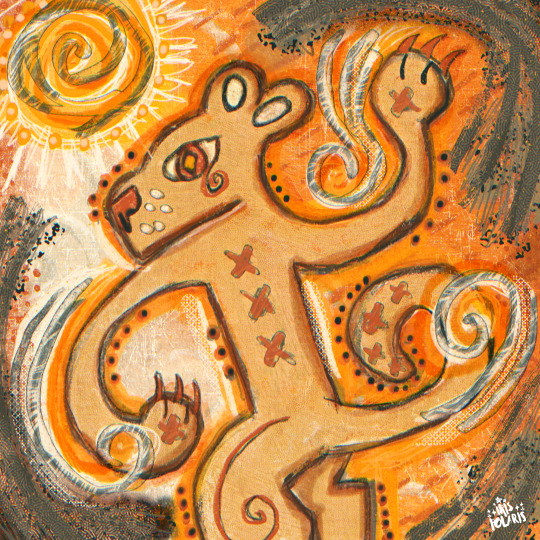
!!sekhmet vs the shadows!! (digital, 2023)
#digital art#original art#sekhmet#kemetism#kemetic#kemeticism#devotional art#naive art#primitivism#art#artists on tumblr#lioness#goddess
266 notes
·
View notes